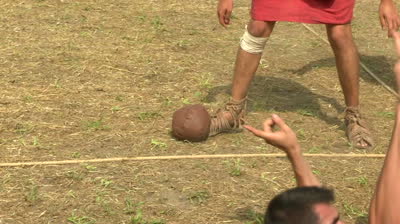Historical Commentary. Football or soccer is the most popular sport in Africa. Wherever you travel on that vast continent, you’ll see young boys kicking a ball and while they are having fun, they are also improving their motor skills.
Sometimes, the ball is made from old newspapers, string or plastic bags wrapped around a stone.
Most people think of football as a modern game that was introduced by European colonialist into Africa just over a hundred years ago. However, the earliest records of something resembling football can be traced back to Ancient Egypt.
Artefacts dating back to 2500 BCE were found in the tomb of Baqet 1l1, depicting young women playing this sport. Little is known about the Ancient Egyptian game, but historians believe that during fertility rites, linen balls of seeds were booted across the field. For better bouncing, balls were made out of cat gut, then wound into a sphere and wrapped in leather or deer skin.
Later, Harpastum, a form of football was introduced to the British Isles by Roman soldiers during the Roman invasion of Britain. Harpastum was a team game, played to maintain the physical fitness of the Roman soldiers. It was played on a rectangular field with a variable number of players and bore more of a resemblance to the game of Rugby.
Greek grammarian, Anthenaeus describes the game:”He seized the ball and passed it to a team-mate while dodging another and laughing. He pushed it out of the way of another. Another fellow player, he raised to his feet. All the while the crowd resounded with shouts of out of bounds, too far, right beside him, over his head, on the ground, up in the air, too short, pass, it back in the scrum.”
Although records exist that the game was played between Roman soldiers and the British, it wasn’t until the Middle Ages that football became popular with annual Shrovetide matches. The games involved any number of players and were normally disorganised and violent with regional variations being played throughout the country.
It was not uncommon for a thousand people to play in a single game, which lasted all afternoon, beginning again the following day if no goal was scored. Although the game began to gain popularity amongst ordinary people, it was largely disliked by the aristocracy, who only approved of the kind of sports that were played on horseback.
By the 11th century, games were often played between rival villages to ‘settle old scores’ and land disputes, as they engaged in manly tribal aggression. The pitch was not a defined size and included streets, fields, streams, village squares and anything else that got in the way and goal posts were often miles apart.
By the 12th century, an annual competition had been established in London. Such records also point to women being involved in the game. Every Shrove Tuesday, the game created huge interest and gained further popularity. Shrovetide was a time for a last fling before Lent.
It was originally an important pre-Christian spring festival, and the last day of carnival, but more importantly, it was a time for pagan rituals intended to enhance productivity and fertility in the summer months ahead. It was also a time to use up meat, eggs and butter and it was a time for games. Later, other holy days became a time for playing football.
Soon street matches became so popular in London that traders called on King Edward ll to outlaw the game in the city. In 1314, the first law banning football was introduced and a proclamation was issued stating that: “Forasmuch as there is a great noise in the city caused by hustling over large balls, from which many evils arise which God forbid we command and forbid, on behalf of the King, on pain of imprisonment such game to be used in the city in the future.”
Later King Edward lll repeated the prohibition in 1349 and 1363, describing football as one of many “foolish games which are of no use.” The ban was ineffective despite the threat of imprisonment, and subsequent attempts to prohibit football all met with similar results.
The only ban with any level of effectiveness was imposed by Oliver Cromwell in the 1600s. Although a keen footballer in his youth, Cromwell’s ban on Sunday football remained in force for over thirty years.
Supporting the ban, fellow Puritan, Philip Stubbes wrote: “…football is more a bloody murthering practice than a fellowly sport or pastime.” Yet, despite many attempts to ban it, football survived and remained a lawless and unruly game.




